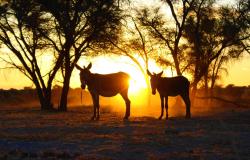
The use of animal derivatives in traditional Chinese medicine (TCM) dates back more than 5000 years. Donkey skins are one such animal derivative, the skins are used to produce ejiao, which is a luxury product and believed by some to have a variety of health benefits. The increasing demand for ejiao is putting the global donkey population at risk. In China between 1990 and 2018 the donkey population decreased by 77 per cent, as a consequence donkeys are largely being sourced from Africa to meet the demand. In low and middle-income countries donkeys are a valuable livelihood asset. Research has emerged highlighting the potential detrimental impacts of the loss of donkeys on livelihoods. In addition to the impact on communities, the trade presents a number of signifcant health and welfare concerns to donkeys. Methods for raising awareness, reducing demand and challenging and enforcing policy are all needed to reduce the impact of the donkey skin trade. Policy change needs to be bottom up, with local bans in countries where the trade is most damaging and coordinated enforcement of legislation, including the tackling of illegal cross border trade. Partnership across non-governmental organisations, agencies and government is essential.
Photo by Roger Brown from Pexels